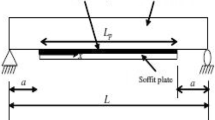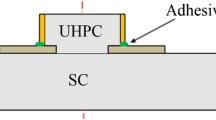Abstract
The paper focuses on debonding propagation along an interface, notably on the major influence of the interlocking between the two faces of the debonding interface. The aim of the study is to obtain the data necessary for relevant and efficient debonding modelling. The work associates experiment and simulation with the purpose of quantifying the interlocking along the interface. The overlay material investigated was a fibre reinforced mortar (FRM). Direct tension tests of notched FRM specimens were firstly conducted to obtain the tensile strength and the residual normal stress—crack width relationship. Its Young's modulus was determined from compression tests. The substrate-overlay interface was investigated by direct tension tests and flexure tests performed on composite substrate-overlay specimens. The direct tension tests provided the interface tensile strength and the relationship between debonding-opening and residual normal tensile stress. Three point flexural static tests informed on the structural behaviour of the interface. The debonding interface propagation was monitored using a video-microscope with a maximum enlargement of ×175.
Using the identified and quantified parameters, modelling of the above mentioned static tests was carried out by the finite elements method using CAST3M code developed in France by CEA (Centre for Atomic Energy). The comparison of modelling and experiment results shows a good coherence and proves the important role of interlocking on the debonding mechanism.
Similar content being viewed by others
References
Grandhaie F, Granju J-L, Ringot E (1993) Durability of pavement repairs, point of view about the role of fibers, in 5th International Conference on Concrete Pavement Design and Rehabilitation, edited by Purdue University, U.S.A., 2:195–202.
Chausson H, Granju J-L (1997) Optimized design of fiber reinforced thin bonded overlays' in Brittle Matrix Composites–-BMC 5, edited by A.M. Brandt, V.C. Li, I.H. Marshall (Woodhead publishing limited–-Bigraf, Cambridge (U.K.) and Warsaw (Pl.)), 133–142.
Granju J-L, Turatsinze A, Farhat H (1998) Les paradoxes des rechargements minces adherents in 3ème Colloque International Francophone sur les Bétons Renforcés de Fibres Métalliques, edited by R. Pleau, M. Pigeon (Centre de Recherche Interuniversitaire sur le Béton, Université Laval, Québec, Canada) 63–76.
Granju J-L (1996) Thin bonded overlays–-About the role of fiber reinforcement on the limitation of their debonding, Advanced Cement Based Materials 4:21–27.
Granju J-L (2001) Debonding of thin cement-based overlays' ASCE Journal of Materials in Civil Enginering 32(2):114–120.
Petersson PE (1981) Crack growth and development of fracture zones in plain concrete and similar materials, report TVBM - 1006, Lund Institute of Technology.
Sadouki H (1987) Simulation et analyse numérique du comportement mécanique de structures composites, Phd thesis (no. 676), Swiss Federal Institute of Technolgy, Lausanne, Switzerland.
Chausson H (1997) La durabilité des rechargements minces adhérents en béton renforcé de fibres métalliques, Phd Thesis of Paul Sabatier University, 9 July.
Farhat H (1999) Durabilité des réparations en béton de fibres: Effets du retrait et de la fatigue, Phd Thesis of Paul Sabatier University, 13 December.
Toumi A, Bascoul A, Turatsinze A (2001) Modeling of fatigue crack growth in concrete subjected to mode I crack opening, FRAMCOS-4, edited by R. De Boist, J. Mazars, G. Pijaudier-Cabot, J.G.M. Van Mier, (A.A. Balkema Publishers) 637–640.
Toumi A, Bascoul A, Tuaratsinze A (2000) Prédiction de la durée de vie du béton sous fatigue–-paramètres caractéristiques, Revue Française de Génie Civil 4:297–307.
Sabathier V, Granju J-L, Bissonnette B, Turatsinze A, Tamtsia B, Thin bonded cement-based overlays: Influence of initial bond defects and fibre reinforcement, in Seventh International Symposium on Brittle Matrix Composites, IFTR–-Poland, October, 2003.
Rahman MK, Baluch MH, Gadhib AH (2000) Simulation of shrinkage distress and creep relief in concrete repair, Composites Part B: Engineering 31(6–7):541–553.
Feron C (2002) Etude des mécanismes de génération de contraintes et de fissuration par retrait gêné dans les structures à base de matériaux cimentaires, Phd Thesis of INSA Lyon, 17 June.
Granger L, Torrenti J-M, Acker P (1997) Thoughts about drying shrinkage: Experimental results and quantification of structure drying creep, Materials and Structures 30:588–598.
Xi Y, Bazant ZP, Jennings HM (1997) Moisture Diffusion in Cementitious Materials: Adsorption Isotherms, Advanced Cement Based Materials, 1(6):248–257.
Torrenti JM, Granger L, Diruy M, Genin P (1997) Modélisation du retrait du béton en ambiance variable, Revue Française de Génie Civil, 1(4):687–698.
Granju J-L, Sarkis M, Arnaud M, Escadeillas G (2004) Temps zéro de référence pour les mesures de retrait, Materials and Structures 37:449–455.
Author information
Authors and Affiliations
Rights and permissions
About this article
Cite this article
Tran, Q.T., Toumi, A. & Granju, JL. Experimental and numerical investigation of the debonding interface between an old concrete and an overlay. Mater Struct 39, 379–389 (2006). https://doi.org/10.1007/s11527-005-9051-2
Received:
Accepted:
Published:
Issue Date:
DOI: https://doi.org/10.1007/s11527-005-9051-2




